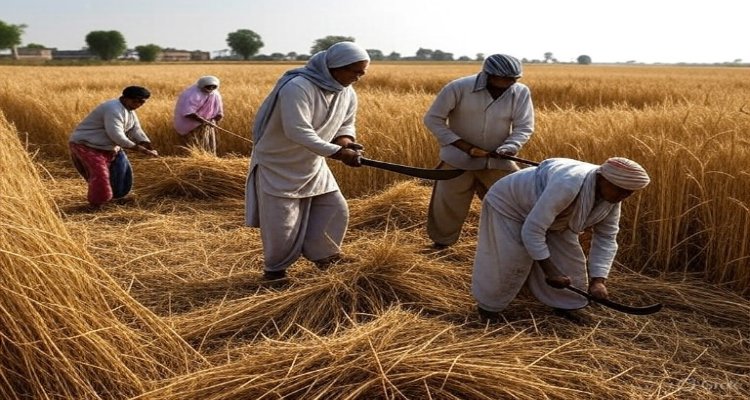Centre Tightens Wheat Stock Norms to Rein in Prices Ahead of Festive Season
The Centre has revised wheat stock limits for traders, retailers, and processors until March 31, 2026, to stabilize prices, curb hoarding, and ensure availability before the festive season.
Introduction: A Crucial Step to Rein in Food Inflation
In a decisive move to prevent price escalation of wheat ahead of India’s peak festive season, the central government has tightened stock-holding norms for wholesalers, retailers, and processors. The new order, valid until March 31, 2026, is aimed at curbing hoarding practices, stabilizing prices, and ensuring smooth availability of wheat in the domestic market. With inflationary pressures and consumer demand expected to rise during festivals, the Centre’s intervention marks a proactive approach to protect households and maintain market balance.
Background: Balancing Record Production with Market Stability
India, the world’s second-largest wheat producer, recorded an all-time high output of 117.5 million tonnes in 2024–25. The procurement drive for the 2025–26 marketing year also reached 30.03 million tonnes, boosting the government’s foodgrain reserves.
Yet, despite ample supplies, price volatility has remained a concern. Factors such as speculative stockpiling, uneven supply distribution, and festive-driven demand spikes have historically led to sharp price rises in essential food commodities.
The government initially imposed wheat stock limits in June 2023, extending them until March 2024. Since then, multiple revisions—in June, September, and December 2024, and again in February and May 2025—highlight the Centre’s responsiveness to market fluctuations.
Main Developments: What Has Changed?
Under the latest revision, the Department of Food and Public Distribution has reduced holding capacities across the supply chain:
-
Wholesalers: Maximum wheat stock reduced from 3,000 tonnes to 2,000 tonnes.
-
Retailers: Each outlet can hold 8 tonnes, down from 10 tonnes.
-
Big Chain Retailers: Similarly capped at 8 tonnes per outlet, down from 10 tonnes.
-
Processors: Allowed to stock 60% of their monthly installed capacity, compared to 70% earlier, multiplied by the remaining months of the fiscal year.
All entities covered under the order must:
-
Register on the Wheat Stock Limit Portal (foodstock.dfpd.gov.in).
-
Update stock positions weekly (every Friday).
-
Dispose of excess stock within 15 days, if holdings exceed the prescribed cap.
Non-compliance will attract penalties under the Essential Commodities Act, 1955, which empowers authorities to penalize hoarders and profiteers in situations of artificial scarcity.
Expert Insight and Public Sentiment
Agricultural economists suggest the move is preventive rather than corrective, ensuring early intervention before demand kicks in during September–December, the most consumption-heavy months.
“The record harvest doesn’t automatically guarantee price stability,” said Dr. Anil Verma, a food policy expert. “Supply chain discipline is critical. By tightening stock norms, the government is signaling that hoarding won’t be tolerated.”
Market insiders also see this as a confidence-building measure for consumers. Retail association representatives, however, warn that frequent policy changes may complicate operations for traders and processors.
On the consumer side, the move has been largely welcomed, as stable wheat prices directly influence the affordability of flour and related food products across households.
Impact & Implications
For Traders & Processors
Wholesalers and processors must adjust to lower stock limits, which might affect their logistical planning and working capital cycles. Reduced limits could also increase supply rotation frequency, encouraging smoother market inflows.
For Consumers
Stable wheat and atta prices during festive demand are the biggest expected benefits. With food inflation being politically sensitive, the government’s move could shield households from sudden price shocks.
For the Government
The announcement reiterates the government’s aggressive monitoring strategy, balancing the twin objectives of food affordability and farmer incentives. It also reflects lessons from recent years, when global supply disruptions due to the Russia-Ukraine war pushed wheat prices significantly higher.
Looking Ahead: A Watchful Policy Environment
While the current order extends until March 31, 2026, analysts expect further tweaks depending on crop forecasts, procurement trends, and inflation data. The Centre’s priority will remain to maintain food security while ensuring that farmers receive fair prices and consumers have affordable access.
With another procurement season approaching in April 2026, the government is likely to recalibrate stock norms again, based on actual market dynamics. Until then, vigilance and weekly monitoring through the online portal will act as a deterrent against hoarding practices.
Conclusion
The tightening of wheat stock norms demonstrates the Centre’s continued vigilance against price instability in a critical staple crop. By proactively revising limits well before the festive season, the government aims to safeguard consumer interests, ensure equitable supply, and send a strong anti-hoarding message.
As India navigates rising demand and global uncertainties, timely interventions like these highlight the balancing act between production abundance and market discipline—a crucial factor in ensuring food security for over a billion citizens.
Disclaimer: This article is based on official government announcements and publicly available data. It is intended for informational purposes only and does not constitute financial or trading advice.











